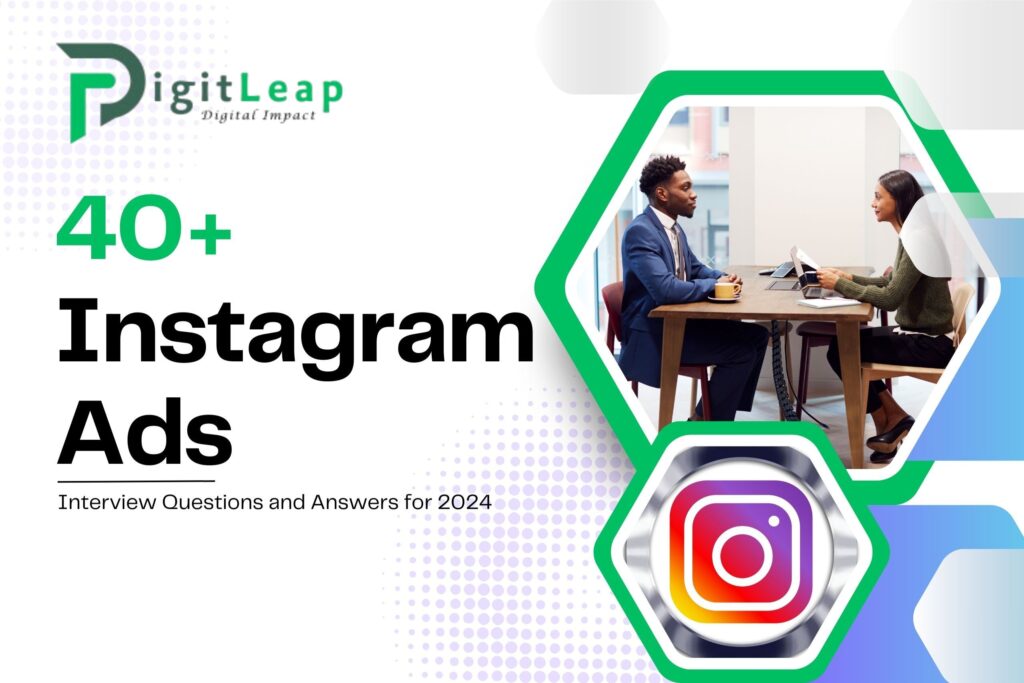40+ Instagram Ads Interview Questions and Answers for 2025
In today’s digital marketing landscape, Instagram Ads have become a crucial tool for brands looking to engage audiences and drive conversions. Whether you’re preparing for an interview or simply want to brush up on your knowledge, here’s a humanized, easy-to-understand list of over 40 Instagram Ads interview questions along with sample answers that reflect the latest trends for 2025.

General Questions
- What are Instagram Ads and why are they important?
Answer: Instagram Ads are paid promotional posts that appear on users’ feeds, Stories, and explore pages. They are important because they allow brands to reach a highly engaged audience with visually appealing content, driving awareness and conversions. - How has Instagram Ads evolved in recent years?
Answer: Instagram Ads have grown more sophisticated, integrating features like Stories, Reels, and Shopping. The platform now leverages advanced targeting options and AI-driven insights to help advertisers reach specific audience segments more effectively. - What makes Instagram Ads different from other social media ads?
Answer: Instagram Ads focus heavily on visual storytelling and creativity. With its unique formats like Stories and Reels, along with a highly engaged, visually driven audience, it offers a unique blend of aesthetics and functionality that sets it apart.
Ad Formats and Creative Strategy
- What are the main ad formats available on Instagram?
Answer: The key formats include Photo Ads, Video Ads, Carousel Ads, Stories Ads, Reels Ads, and Collection Ads. Each format caters to different objectives, whether it’s storytelling, product showcases, or driving traffic. - How do you choose the right ad format for a campaign?
Answer: It depends on your campaign goal. If you want to showcase multiple products, Carousel Ads work well. For immersive storytelling, Video or Reels Ads are ideal. The target audience and campaign objectives will guide your choice. - What role does creative play in Instagram Ads?
Answer: Creative is vital. High-quality visuals and engaging copy capture attention and drive engagement. Experimenting with different creative assets, testing various formats, and ensuring brand consistency are key to success. - How do you ensure your ad creatives are optimized for mobile?
Answer: Since most users access Instagram on mobile, it’s essential to use high-resolution images, concise messaging, and vertical or square formats that fit mobile screens perfectly. Testing on multiple devices is also important.
Targeting and Campaign Setup
- What targeting options does Instagram offer?
Answer: Instagram provides detailed targeting based on demographics, interests, behaviors, and location. You can also use custom audiences, lookalike audiences, and retargeting to reach the right people. - How do you create a custom audience for Instagram Ads?
Answer: You can upload your customer lists, use website traffic data via Facebook Pixel, or engage with users who interact with your content. This helps create tailored campaigns that resonate with specific audience segments. - What is a lookalike audience and how do you use it?
Answer: A lookalike audience is a group of users who share similar characteristics with your existing customers. By targeting lookalike audiences, you can expand your reach to potential customers who are likely to be interested in your products. - How do you set up an Instagram Ads campaign?
Answer: You start by selecting your objective in Facebook Ads Manager, defining your audience, choosing your ad format, setting your budget, and designing your creative. It’s a step-by-step process that ensures your campaign aligns with your business goals.
Budgeting and Bidding
- What bidding strategies are available for Instagram Ads?
Answer: You can choose between manual bidding and automated bidding strategies like Target CPA or Maximum Conversions. The right strategy depends on your campaign goals and budget flexibility. - How do you determine the budget for your Instagram Ads campaign?
Answer: Budgeting involves analyzing your marketing goals, historical campaign performance, and competitive benchmarks. Start with a test budget, monitor performance, and scale up as needed. - How do you optimize your bids for better ROI?
Answer: Regularly monitor your campaign performance, adjust bids based on conversion data, and use automated bidding tools that leverage machine learning to maximize your return on ad spend.
Analytics and Performance Measurement
- What metrics are most important for measuring Instagram Ads performance?
Answer: Key metrics include impressions, click-through rate (CTR), engagement rate, conversion rate, cost per click (CPC), and return on ad spend (ROAS). These help you gauge the effectiveness of your ads. - How do you track conversions from Instagram Ads?
Answer: Use Facebook Pixel or Conversion API to track user actions on your website, such as purchases or sign-ups. This data helps you understand which ads drive results. - What tools do you use to analyze campaign performance?
Answer: Facebook Ads Manager, Instagram Insights, and third-party analytics tools like Hootsuite or Sprout Social provide detailed data to help refine your strategy. - How do you use A/B testing in Instagram Ads?
Answer: A/B testing involves creating two variations of your ad (different visuals, headlines, or CTAs) and comparing their performance. This process helps identify the most effective elements, which you can then scale.
Optimization and Strategy
- How do you optimize your ad creatives for better performance?
Answer: Continuously test different images, videos, and copy variations. Analyze which creatives generate the most engagement, and refine your approach based on user feedback and performance data. - What strategies do you use to combat ad fatigue?
Answer: Regularly refresh your ad creatives, update your targeting, and rotate ad variations to keep your audience engaged and avoid repetitive messaging. - How do you integrate Instagram Ads with your overall marketing strategy?
Answer: Instagram Ads should complement other channels like email marketing, content marketing, and SEO. Consistent messaging and cross-channel promotion help reinforce your brand and drive cohesive results. - What are some emerging trends in Instagram Ads for 2025?
Answer: Trends include the rise of interactive ads, increased use of augmented reality (AR) filters, video content in Reels, and deeper integration with e-commerce features like Instagram Shopping.
Campaign Management and Best Practices
- How do you manage multiple Instagram Ads campaigns simultaneously?
Answer: Use tools like Facebook Ads Manager and social media management platforms to organize and monitor campaigns. Establish clear objectives and regularly review performance to keep everything on track. - What is the importance of ad scheduling in Instagram Ads?
Answer: Scheduling allows you to target your audience at optimal times when they are most active, increasing the likelihood of engagement and conversions. - How do you handle negative feedback or low-performing ads?
Answer: Monitor comments and feedback closely. For low-performing ads, analyze the data, tweak the creative or targeting, and consider testing a new approach. Promptly addressing negative feedback can also improve your brand reputation. - How do you balance paid and organic efforts on Instagram?
Answer: A successful strategy uses paid ads to boost reach and drive conversions while maintaining organic content that engages your community. Both efforts should work together to build a strong, authentic brand presence. - What role does influencer collaboration play in Instagram Ads?
Answer: Influencers can amplify your message and add credibility. Collaborate with influencers whose audience aligns with your target market, and integrate their content with your ads for a more relatable and trustworthy campaign. - How do you ensure consistency across your Instagram ad campaigns?
Answer: Maintain a unified brand voice, visual style, and messaging across all ads. Use creative templates and guidelines to ensure that every ad reflects your brand identity. - What challenges have you encountered with Instagram Ads and how did you overcome them?
Answer: Common challenges include ad fatigue and high CPC. I’ve overcome these by regularly testing new creatives, refining targeting parameters, and using automated bidding strategies to optimize spend. - How do you use customer data to refine your Instagram Ads strategy?
Answer: Analyzing customer behavior and engagement metrics helps tailor your messaging and targeting. Data-driven insights allow you to understand what resonates with your audience and adjust your campaigns for better performance. - How do you leverage Instagram Stories in your ad strategy?
Answer: Stories offer a dynamic, full-screen experience that’s perfect for time-sensitive promotions and behind-the-scenes content. Their ephemeral nature can create a sense of urgency, driving quick engagement. - What is a Carousel Ad and when should you use it?
Answer: Carousel Ads allow you to showcase multiple images or videos in a single ad unit. They’re ideal for highlighting different products, features, or a step-by-step story, providing a more interactive experience. - How do you measure the success of an Instagram Ad campaign?
Answer: Success is measured by tracking key performance metrics such as CTR, conversion rate, CPC, engagement, and overall ROI. Regular analysis helps determine which strategies are effective and where adjustments are needed. - What role does remarketing play in your Instagram Ads strategy?
Answer: Remarketing helps re-engage users who have previously interacted with your brand. By targeting these warm leads, you can boost conversion rates and nurture relationships, making your campaigns more effective. - How do you keep up with changes in Instagram’s advertising platform?
Answer: I follow industry blogs, participate in webinars, and engage in professional communities to stay updated on the latest features, best practices, and policy changes. - What are some cost-effective ways to boost your Instagram Ads performance?
Answer: Focus on high-quality, engaging content, narrow your targeting to reach the most relevant audience, and use A/B testing to continually refine your ads. Monitoring and adjusting bids based on performance also helps maximize ROI. - How do you ensure your ad copy is engaging and persuasive?
Answer: I craft ad copy that speaks directly to the needs and interests of my target audience, using clear calls-to-action and emotional triggers. Testing different versions helps identify what resonates best. - What strategies do you use to optimize your landing pages for Instagram Ads?
Answer: Ensure that landing pages are mobile-friendly, load quickly, and align with the ad’s messaging. A clear, compelling call-to-action on the landing page is key to converting visitors into customers. - How do you incorporate video into your Instagram Ads?
Answer: Video ads capture attention quickly. I use short, engaging videos that tell a story or demonstrate a product’s value. Optimizing video content with captions and clear visuals ensures better engagement, especially on mobile. - How do you integrate Instagram Ads with broader marketing campaigns?
Answer: Integration is achieved by aligning messaging across channels, sharing content between organic and paid efforts, and using consistent branding. This cohesive approach helps reinforce your overall marketing strategy. - How do you approach budgeting for Instagram Ads?
Answer: I set clear campaign goals and allocate budgets based on past performance and expected ROI. Monitoring spend and adjusting bids based on real-time data ensures that the budget is used effectively.
Conclusion
These 41 questions and answers cover a wide range of topics that are essential for anyone looking to master Instagram Ads in 2025. By understanding platform features, creative strategies, data-driven optimization, and integration techniques, you can build a robust and effective Instagram Ads strategy. Whether you’re interviewing for a role or looking to refine your skills, these insights will help you stay ahead in the competitive world of social media advertising.






